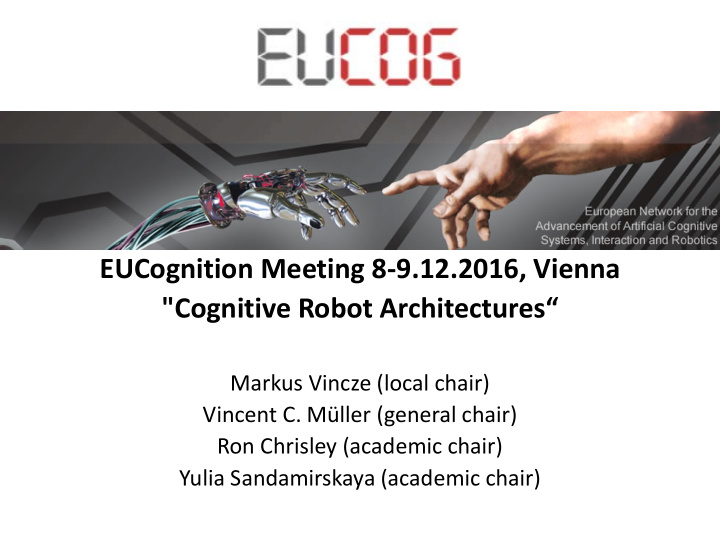



EUCognition Meeting 8-9.12.2016, Vienna "Cognitive Robot Architectures“ Markus Vincze (local chair) Vincent C. Müller (general chair) Ron Chrisley (academic chair) Yulia Sandamirskaya (academic chair)
What Do Industrial Developers and End-Users Expect from a Cognitive Robot? David Vernon 1 & Markus Vincze 2 1 University of Skövde, Swede 2 Technische Universität Wien, Austria EUCog – European Association for Cognitive Systems 8-9 December 2016
What developers and their customers want Questionnaire of AICoR Topic Group, euRobotics Interviews with selected key persons in industry • Tim Guhl, KUKA Systems GmbH (*) 2/8/2016 • Patrick Courtney, Tec-Communication (*) 2/8/2016 • Rich Walker, Shadow Robot Company (*) 23/8/2016 • Maja Rudinac, Robot Care Systems (*) 30/8/2016 • Slawomir Sander, KUKA Systems GmbH ( ) 30/8/2016 • David Ball, Bosch () 30/8/2016 • Andrew Graham, OC Robotics () 7/9/2016 • Mauricio Calva, Chevron (*) 12/9/2016 • Amit Kumar Pandey, Softbank Robotics (*) 12/9/2016 • Ugo Cupcic, Shodaw Robot (*) 12/9/2016 • Daniel Wäppling, ABB (*) 19/9/2016 • Ekkehard Zwicker, GE Inspection Robotics (*) 19/9/2016 • Thilo Steckel, CLAAS E-Systems KGaA mbH & Co KG (*) 28/9/2016
What developers and their customers want • Cognitive Abilities Cx • Autonomy Ax • Goals Gx • Instruction Ix
Cognitive Abilities C1 Safety and reliability Robots help people and prioritize their safety ? Only reliable behavior will build trust in cognitive robots Should be able to explain their actions
Cognitive Abilities C2 Implicit, task-oriented programming Use high-level instructions that will ? exploit the robot’s contextual knowledge of the task
Cognitive Abilities C3 Task knowledge C3.1 Contextual task knowledge ? • Pre-select information that is important to effectively carry out the task. E.g., vase: leave or • empty table
Cognitive Abilities C3 Task knowledge C3.2 Continuous knowledge acquisition ? • Build and exploit experience • Robot decisions incorporate present and long term data • E.g., route planning in factory/hospital: use previous paths, take another look to overcome uncertainty
Cognitive Abilities C3 Task knowledge C3.3 Knowledge generalization ? • Generalise knowledge to new task extrapolating from previous experience E.g., reuse knowledge • of rehabilitation exercise to another person; welding a new instance of a family of parts
Cognitive Abilities C4 Cope with unforeseen situations, error handling Recognise errors • ? • Recover from errors • Anticipate and compensate
Cognitive Abilities C5 Individualized operation Adapt behavior and interaction policy to the ? user’s preferences, needs, and emotional state
Cognitive Abilities C6 Reason about own capabilities Given a task, robot is able to say ? whether it can do it or not
Cognitive Abilities C7 Task learning From high level input, e.g., speech, gestures ?
Cognitive Abilities C8 Action learning, e.g., from demonstration The entities involved and their usage usage
Cognitive Abilities C9 Self-optimization Continuous improvement based on its own actions and those of others ? (people or other robots)
Cognitive Abilities C10 Communicate robot intentions To people around it so that they can anticipate ? the robot’s actions and intentions
Cognitive Abilities C11 Knowledge transfer From one robot to another robot with a different physical, ? kinematic, and dynamic configurations
Autonomy A1 Goal set by user The robot should not have freedom to set its goal.
Autonomy A2 Setting intermediate goals Those that support the overall goal set by a user ? may be allowable within limits
Autonomy A3 Formal limits of autonomy To assure any new action, task must be ? carried out in a safe manner
Autonomy A4 Knowledge and reasoning about the limits The robot needs to know ? what is normal, i.e. expected, behaviour (perhaps based on documented rules or practices)
Goals G1 High-level goal specification That reflects the user’s perspective ? Specified in a formalised and structured way Designer defines goals and can verify them
Goals G2 Knowledge about the robot purpose Used as contextual knowledge to enable the ? goal specification Pre-load knowledge about the robot’s purpose A ssist user by proposing goals from what it understood user makes the final selection
Instruction I1 Teaching by demonstration of robot actions Instructions should be ? ? communicated by demonstration Or high level commands
Instruction I2 Teaching the application context To simplify goal specification ? Step by step teaching: robot knows more and more
What developers and their customers want • Cognitive Abilities • Safety, error detection & handling, individualise • Task & action learning, knowledge, optimise • Reasoning/communicate about own capabilities • Autonomy • User sets goal, robot intermediate steps • Reasoning about limits, new but safe actions • Goals • Specified at high level, robot knows about purpose • Instructions • Teaching by demonstration, learn application context
“Exponential Technologies” Industry 4.0 requires automation solutions to be highly cognitive and highly autonomous It requires enhanced collaboration between humans and machines , including next generation robots that work hand- in-hand and safely with humans [Deloitte 2014] https://www.accenture.com/us-en/digital-industry-index
What developers and their customers REALLY want “Training a robot like an intern or an apprentice” • Trainer: “Has someone shown you how to do this? • “No? Okay, I’ll show you how to do three, then you do 100 to practice (and to throw away afterwards).” • “If you get stuck on one, call me, and I’ll show you how to solve that problem.”
Industry 4.0 Fourth Industrial Revolution Enabled by networking among an internet of things, services, data, and people Cyber-Physical Systems CPS Online networks of social machines Industry 4.0 - Challenges and solutions for the digital transformation and use of exponential technologies, Deloitte, 2014.
Recommend
More recommend